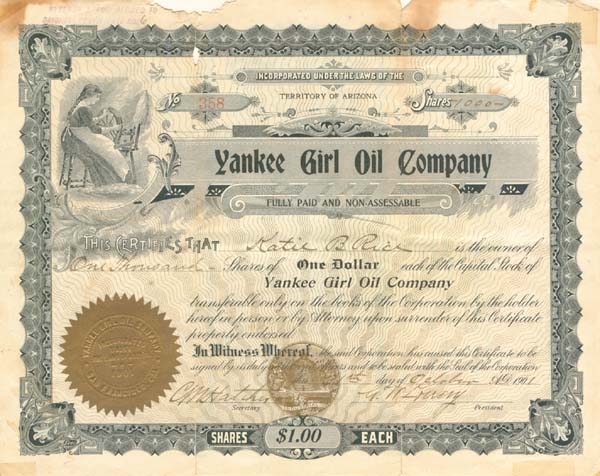The discovery of the Los Angeles City oilfield by Edward Doheney in 1892 set off a boom that within a few years put more than 200 oil companies and 2,500 wells within Los Angeles city limits.
Yankee Girl Oil Company was one of them.
Among the new companies seeking “black gold” riches in southern California, Yankee Girl Oil organized in July 1901 in the Territory of Arizona and capitalized at $400,000.
 Based in San Francisco, the company acquired leases in the Los Angeles City field and drilled its first two wells between today’s Colton and West Court streets just north of Vista Hermosa Natural Park.
Based in San Francisco, the company acquired leases in the Los Angeles City field and drilled its first two wells between today’s Colton and West Court streets just north of Vista Hermosa Natural Park.
Investors – and speculators – bought Yankee Girl Oil shares for about 40 cents each. Investment analysts offered their qualified approval.
“The holdings appear to be such that with capable management and sufficient time and capital for development the stock should become of value,” United States Investor reported.
“Well No.1 was completed about a year ago and has been yielding oil steadily since,” noted a November 1901 article in Pacific Oil Reporter. “The company owns its own tanks, and the wells are pumped by the most improved pumping plant obtainable.”
Although each of Yankee Girl Oil’s two wells produced oil (totaling about 32 barrels a day), increased drilling and production costs and fierce competition did not bode well for the exploration company.
The Los Angeles City oilfield reached peak production of over 2,200 barrels a day. Learn more in Discovering the Los Angeles Oilfield.
This continuing glut of supply drove oil prices down to just 15 cents a barrel by 1903.
“There was so much cheap oil that to reduce the tremendous surplus, the city began spraying it on unpaved roads to hold down the dust,” notes one historian.
With low production, no margins, and insufficient capital to continue operations, Yankee Girl Oil Company was one of many fatalities in the scramble for Los Angeles oilfield wealth. Collectible, the company’s stock certificates appear online for sale through scripophily sites.
Also see Discovering the La Brea “Tar Pits” and Oil Queen of California.
The stories of exploration and production companies joining petroleum booms (and avoiding busts) can be found updated in Is my Old Oil Stock worth Anything? The American Oil & Gas Historical Society preserves U.S. petroleum history. Please support this AOGHS.ORG energy education website. For membership information, contact bawells@aoghs.org. © 2020 AOGHS.
___________________________________________________________________________________
___________________________________________________________________________________

